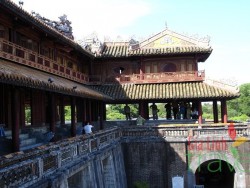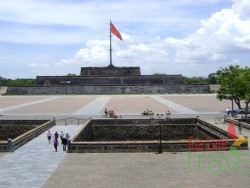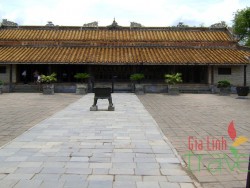Hue
Hue’s Royal Tombs
Hue Hue Six royal tombs are scattered throughout land to the south east of the citadel at the other side of the Perfume River and one on the same side. They are monuments to nine of the thirteen rulers of the Nguyen Dynasty, most commonly constructed right through the Emperor’s existence time. Despite the fact that designed in my view, a few times by way of the intended occupant himself, they percentage certain design conventions. All had been constructed according to strict laws of geomancy, which often concerned making substantial modifications to the panorama to ensure that the sight strains and orientation of the constituent elements complied with celestial and supernatural forces. Those had been · A courtyard with stone effigies of elephants, horses and mandarins · A pavilion containing an incredible stele with eulogies to the departed incumbent · A temple containing an altar for worshipping the Emperor’s soul · A pleasure pavilion, and · The tomb itself Each Royal Tomb displays the character of the ruler. 3 of the tombs draw in large numbers of tourists: Minh Mang The most majestic is that of Emperor Minh Mang, a staunch follower of Confucianism with many wives, concubines and a small military of children. Planned via the Emperor and built shortly after his demise, it’s opulent and exotic, and laid out in formal Chinese style. With the imaginable exception of Khai Dinh’s monument, no different tomb strategies the level of harmony of the elements of Minh Mang’s tomb. Its structure and symmetry draws the attention evidently towards the main features, and the architectural balance blends the weather into a satisfying whole. Tu Duc The tomb of Tu Duc, the ‘poet Emperor’, is set in an elegant garden with an impressive lake and pavilion complex. The centerpiece of the tomb is simplicity itself regardless of the lavish opulence of his reign (it’s truly only a monument – he was buried in other places to thwart grave robbers). In spite of his cultural pursuits and want to achieve a humble lifestyle, it was underneath Tu Duc that the Nguyen court reached its zenith of lavish opulence. Tu Duc withdrew into courtroom lifestyles, reputedly indifferent to the folk he dominated, and the brutal treatment of the three thousand artisans and employees pressed into carrier to build his tomb. Khai Dinh In complete contrast to Emperor Tu Duc’s stylish creation, the tomb of Emperor Khai Dinh is seems to start with to be an unprepossessing concrete construction. Its pastime lies within in an uneasy aggregate of Vietnamese and European options and using fragments of ceramics and glass for decoration. Nevertheless, Khai Dinh’s tomb is of significant passion as an architectural watershed, the cusp between the impacts of a Chinese past and a Western oriented future. The lavish gildings inside the tomb come as a surprise after the grimy and reasonably somber façade and courtyard. A golden effigy of the Emperor seated on his throne under a powerful cement cover extravagantly decorated with ceramic fragments may well be considered a masterpiece. The other 4 tombs are less-visited, but all have attention-grabbing options Gia Long Gia Length’s tomb is the least visited, the furthest from Hue, probably the most tough to get to, but arguably essentially the most significant. The founding father of the Nguyen dynasty, his tomb used to be the template for those that followed. The website is overlooked and overgrown. Alternatively, the damage it received all over the warfare isn’t the primary reason why for its neglect – Gia Lengthy was a cruel tyrant who allied himself with the French and continues to be a hated figure in Vietnamese history. Nevertheless, it’s worth the trip to discuss with the tomb if best to benefit from the atmospheric environment and its vintage design. Thieu Tri Uniquely, Thieu Tri’s tomb was once constructed by means of his son, Tu Duc, in step with his father’s design. As his reign was once relatively brief and the paintings didn’t start until a few times after his accession, his tomb was once not completed whilst he died. Consequently, his frame was once quickly interred within the Long An temple, inside the outer area of the Citadel and now the home of the Museum of Antiquities. Thieu Tri’s design for his tomb was once inspired via that of his father, Ming Mang, however his guide to his son used to be to make it ‘convenient and economical’. Despite the fact that it lacks the flamboyance of his father’s tomb, it’s well designed with a number of distinctive options including a covered bridge very similar to that in Hoi An. Duc, Thanh Thai and Day Tan Even though known as Emperor Duc Duc’s tomb, it’s in truth a small complex that comes with the tombs of 2 different Emperors, Thanh Thai and Duy Tan. It is unexpected that Duc has a tomb at all, as his reign lasted a mere 3 days and he starved to dying in prison. A nephew of Tu Duc, he was once selected via the Emperor to be his successor as he had no son to apply him. However, he used to be quickly deposed by means of individuals of the court who were displeased via his closeness to the French. Legend has it that he was taken to be buried tied up in a hurry mat. Then again, halfway to the intended burial website, the rope broke and the two males carrying the frame made up our minds to bury him there and then. Six years later, his son Thanh Thai constructed a tomb for his father around the makeshift grave. Ironically, both his son and grandson that dominated after Duc, and are buried with him were strongly anti-French and had been deported to Africa by means of the colonialists. Thanh Thai was once ultimately allowed to return to Vietnam but died shortly afterwards in Vung Tau, a year earlier than the French had been after all expelled. His son, Duy Tan, was once sent to sign up for his father in exile, however died in an aeroplane crash. The tomb advanced tomb is only two kilometers from Hue, and is in 3 parts, the Lengthy Dong Khanh The tomb of Emperor Dong Khanh is the smallest, however probably the most individual. He was every other adopted son of Tu Duc who usurped the throne in a while after the French gained regulate of Hue. He dominated as a doggypet Emperor protected by the French, however died after 3 years on the age of 24. His successor, Thanh Thai, lacking finances, transformed the temple that Dong Khanh has built to worship his father into his tomb. It marks a captivating turning element in the evolution of Vietnam’s architecture because it was built at a time whilst Ecu tradition was getting into Vietnam. The interaction between oriental and occidental styles will also be noticed in the use of stained glass, terra-cotta reduction and French artworks amongst conventional Chinese and Vietnamese features. Later, this development would be taken to an extreme in the uneasy fusion of those disparate components in Emperor Khai Dinh’s unusual concrete edifice.


A temple, Duc Duc’s tomb and the tombs of his son and grandson.
